| Columns Retired Columns & Blogs |
Mirage OM-6 loudspeaker Measurements
Sidebar 3: Measurements
John Atkinson measured the Mirage OM-6 and provided me with the results after my listening tests were completed.
The Mirage's sensitivity measured 87dB/2.83V/m (B-weighted). The impedance of the unpowered midrange/tweeter module is shown in fig.1. The mid/tweeter section is tuned to 112Hz. The rise in the impedance magnitude below 80Hz is typical of a system with a series capacitor. The latter is undoubtedly designed to prevent overdriving the mid-tweeter module with low bass, as there is no other high-pass filter in the circuit (unless the user adds one, as discussed earlier). The small ripple visible at 22kHz is the ultrasonic tweeter resonance; another small resonance-indicating ripple is visible at about 280Hz. The minimum impedance is 3.8 ohms at 350Hz, and the phase characteristics are relatively benign. The OM-6 should not be an especially difficult load for any well-designed amplifier.
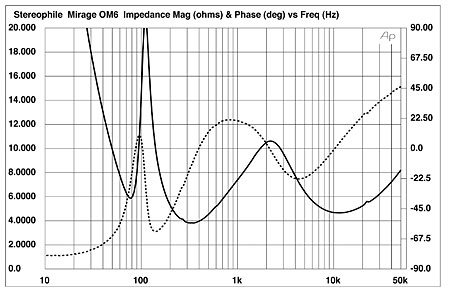
Fig.1 Mirage OM-6, electrical impedance (solid) and phase (dashed) (2 ohms/vertical div.).
Fig.2 (top curve) shows the FFT-derived frequency response of the OM-6's midranges and tweeters taken on the high-frequency axis, combined with the nearfield responses of the two powered woofers, set to "+3" and "0." Note that with the LF equalization set to +3 (where it remained for much of my listening), there is less output below 37Hz than with the control set to flat. The midrange response here is unusually smooth, with the small, visible midrange modes above the crossover point (about 2kHz) well suppressed by the crossover.
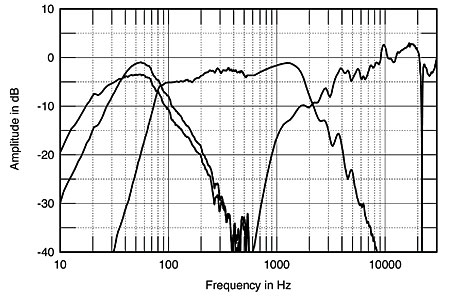
Fig.2 Mirage OM-6, anechoic responses on tweeter axis at 50" of tweeter, and midrange unit, with nearfield midrange and woofer responses plotted below 500Hz. Top woofer response is with the unit set to "+3," bottom set to "0."
Fig.3 is the combined response of the mid/tweeter module averaged across a 30° lateral window, combined with the complex sum of the nearfield bass amd midrange responses. For this measurement, the bass equalization was set to zero. The excellent overall bass extension is still strong at 20Hz—true subwoofer territory. The slight crossover suckout visible at about 75Hz should be insignificant once the room response kicks in. The dip in the low to mid-treble (from about 2kHz to 7kHz) would definitely explain the forgiving quality of the Mirage's sound. But the response bumps just above 1kHz and above 10kHz are counterbalanced somewhat by dips in the OM-6's off-axis response in these regions (see below). Therefore, the subjective effect of the latter deviations—none of which is severe—will depend to a large extent on the room and positioning of the loudspeaker. The Mirage did not sound overly forward in the midrange or peaky in the high end in my room. The slight rise at or around 9–10kHz might explain the slight graininess or dryness I noted on top, but the operative word here for both the measured rise and its subjective impact is "slight."
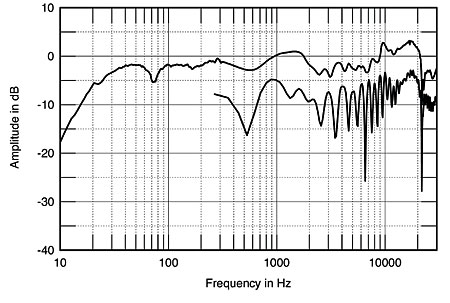
Fig.3 Mirage OM-6, anechoic response on tweeter axis at 50", averaged across 30° horizontal window and corrected for microphone response, with the complex sum of midrange and woofer responses plotted below 300Hz (top). Anechoic response on rear midrange axis at 50", corrected for microphone response and offset by –5dB for clarity (bottom).
The bottom curve in fig.3, displaced by 5dB for clarity, was taken at a horizontal off-axis position of 180°, ie, from behind the speaker. Note the comb filtering beginning in the low treble. This is likely due in large measure to reflections of the loudspeaker's rear radiation from the top of the woofer cabinet. The subjective effect of these "picket-fence ripples"—typical of comb filtering, and here spaced so close together that they're unlikely to be heard as individual peaks and dips—might well be heard as added airiness and spaciousness rather than rough or uneven response. Still, the suckout at 550Hz might somewhat reduce the sound's overall presence.
Fig.4 shows the OM-6's vertical response family, plotted relative to the on-axis response. (The latter is normalized to flat, with the remaining curves showing the changes as the listener moves off-axis.) This is good performance, a vertical listening position 5–10° below the tweeter axis being about optimum. Since the tweeter axis is 41" from the floor, this ideal height will be very close to a typical listening height for most listeners seated in typical living-room chairs.
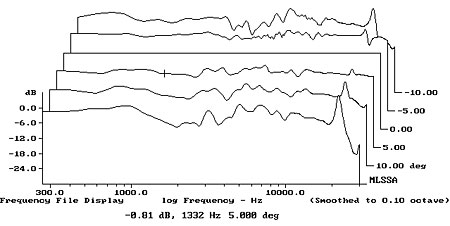
Fig.4 Mirage OM-6, vertical response family at 50", normalized to response on tweeter axis, from back to front: differences in response 10°–5° above-axis; reference response; differences in response 5°–15° below-axis.
The horizontal dispersion, again referenced to a normalized on-axis response, is shown in fig.5. Note here that there is a slight decrease in the off-axis energy just above 1kHz, and an off-axis rolloff just above 10kHz—the possible effects of which were discussed above. Overall, however, the OM-6's off-axis response is well-controlled, without any serious discontinuities. The peak due to the tweeter resonance at 22kHz is more pronounced to the sides, which might well lead your pet bat to prefer napping on-axis.
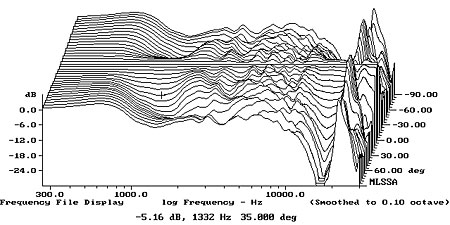
Fig.5 Mirage OM-6, horizontal response family at 50", normalized to response on tweeter axis, from back to front: differences in response 90°–5° off-axis; reference response; differences in response 5°–90° off-axis.
Figs.6 and 7 show, respectively, the impulse and step responses of the OM-6's mid/tweeter module. (The ripples visible just beyond 7ms are room reflections, and are more pronounced here than usual due to the loudspeaker's wide radiation pattern.) The impulse response is very good. The step response indicates that all drivers are connected in the same polarity. The loudspeaker is not time-coherent, the midrange delayed just under 1ms behind the tweeter. The slight jog in the response curve at about 5ms is likely the delayed response of the rear midrange driver.
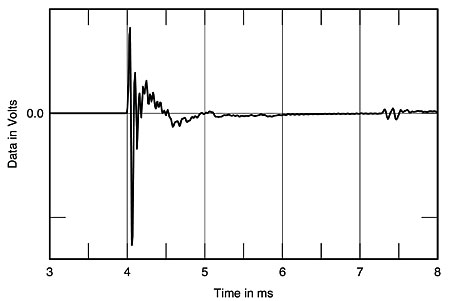
Fig.6 Mirage OM-6, impulse response on tweeter axis at 50" (5ms time window, 30kHz bandwidth).
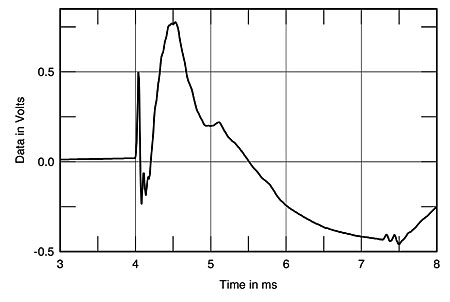
Fig.7 Mirage OM-6, step response on tweeter axis at 50" (5ms time window, 30kHz bandwidth).
The OM-6's cumulative spectral-decay or "waterfall" plot is shown in fig.8. The response here is very clean, with little or no hash, and a mere hint of what could be a delayed mode from the midrange units at just under 10kHz.
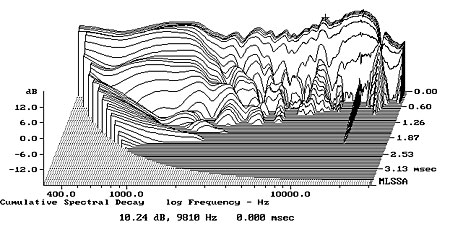
Fig.8 Mirage OM-6, cumulative spectral-decay plot at 50" (0.15ms risetime).
Altogether, there is little to criticize in this set of results, which go a long way toward explaining the impressive performance of the OM-6 in the listening room.—Thomas J. Norton
- Log in or register to post comments




































